I fell in love with this model the first time I saw it, and every time I see it I still smile. With its sophisticated use of materials, including that of Sèvres busts, and the humor of juxtaposing the two great French philosophers of the eighteenth century, Voltaire and Rousseau, it displays itself as a show piece. It also is a design display to show a skill, that of the double stair that spirals as it revolves around a central space resolving itself into a central staircase that reverse-curves up to another level and a work of superb craftsmanship, that of veneering a carpet that perfectly aligns with the curves of the stair case. The “carpet” is two-toned, the lighter main carpet contrasting with a separate veneer in ebony, each parallel to each other and the curve of the staircase. The art of veneering in ebony was considered in France to be the highest form of cabinet-making as ebony is so hard and brittle, and it is expensive. Consequently only the best craftsmen would be entrusted with ebony, and thus they were called ébénistes.
The maker of this model showed himself to be both an accomplished turner-look at how thin and precise the balusters of the stair rail are- and an accomplished ébéniste. Ébénistes made some of the most exactingly inlaid commodes and other pieces of furniture especially during the reigns of Louis XV and XVI. However, here there is no fancy floral decoration or elaborate scrollwork to suggest that era.
The refined proportions and lack of carving show this to be a work of the neo-classical period. While both Voltaire and Rousseau died in 1778, this does not mean the model dates to their lifetimes. They continue to be widely admired and read and Sèvres, which had created life size busts in their lifetime and at their death, started to market the miniature busts in the first years of the 19th century. The staircase seems to be intended to hold rise towards them, but never reach them on their elongated, elevated plinths. The philosophers look down from their lofty posts on everyone who tries to ascend the staircase, the kind of conceit a thoroughly proficient master could do for his own, or someone else’s pleasure. The busts allude to some of the Enlightenment ideals that circulated widely at the end of the eighteenth and early nineteenth centuries, as both Voltaire and Rousseau were Enlightenment figures. Their interactions were often contentious, as Voltaire had parodied Rousseau early in the latter’s career, and then they had parried back and forth when both were later based in Geneva, until real embitterment came with the surreptitious publication of a letter from Rousseau to Voltaire on the latter’s poem about the Lisbon earthquake. Thus, the pedestals of two “pillars” of French philosophy who tangled with tradition had additional impact for almost anyone of the day who would have been aware of Voltaire and Rousseau’s antagonism despite espousing similar ideals much of the time. Compagnonnage artisans were likely to agree with these ideals since they were outside the traditional guild system favored by the monarchy that fell in the French revolution. One of the most articulate of the Compagnonnage masters and leaders starting in the 1820’s was Agricole Perdiguier (1805-1875) who tried to lead three rival groups of Compagnonnage organizations into one for greater effectiveness, as he sought unanimity. Perdiguier was well read, but thought three books central to his life: The New Testament, Rousseau’s Social Contract, and Felicité de Lamennais’s Livre du Peuple.
Thus, this model exists as something of beauty to show mastery, but it also suggests a serious literary and philosophical bent of the maker, for whom this was far more than a work to show proficiency: it is a true masterwork.
This staircase model will be on view beginning December 12th in the Models & Prototypes Gallery, one of Cooper Hewitt’s opening exhibitions.
Sarah D. Coffin is the Head of the Product Design and Decorative Arts Department at Cooper Hewitt Smithsonian Design Museum. She curated, among other exhibitions, Made to Scale: Staircase Masterpieces in The Eugene and Clare Thaw Gift.
